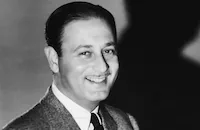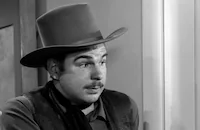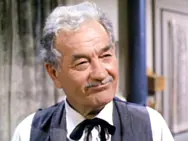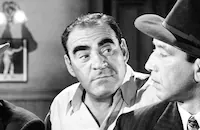The Invisible Agent
Brief Synopsis
Cast & Crew
Edwin L. Marin
Ilona Massey
Jon Hall
Peter Lorre
Sir Cedric Hardwicke
J. Edward Bromberg
Film Details
Technical Specs

Synopsis
Foreign spies Baron Ikito and Conrad Stauffer go to the print shop of Frank Raymond, whose real name is Frank Griffin, in an attempt to buy his grandfather's infamous formula for invisibility. When Frank refuses, they threaten to cut off his fingers, but he manages to escape. Frank then meets with government agent John Gardiner, who asks him to turn over the secret formula to the United States government. Frank tells Gardiner that his grandfather's invention is too hazardous, but he changes his mind when America enters World War II. After he insists that he be the only person to use the dangerous drug, Frank is parachuted into Berlin in order to discover Germany's plans to sabotage the American munitions industry. Using his cloak of invisibility, he eludes a German patrol and meets with his contact, mortician Dr. Arnold Schmidt. Schmidt sends him to the home of double agent Maria Sorenson, who is dining that night with Gestapo officer Karl Heiser. Heiser tells Maria that Hitler has ordered a secret attack on the United States, but does not tell her the exact date after the invisible, and slightly drunk, Frank ruins the Gestapo man's plans for a romantic tryst. Later that night, Stauffer and Ikito return to Berlin, and Stauffer questions Heiser about the missing parachutist and Heiser's activities with Maria. The two Gestapo officers then go to Maria's home, where Stauffer places Heiser under arrest for trying to steal his job and girl friend. Suspecting that Maria is harboring Frank, Stauffer then announces that he has, in his office, the secret plans for the invasion of America. The inexperienced American spy falls for the bait and becomes trapped in Stauffer's office, where, despite his invisibility, he is questioned by the Gestapo officer. Frank manages to escape, however, by setting the office on fire, and takes with him a list of every German and Japanese agent in America. After giving the information to Schmidt, Frank goes to the German prison holding Heiser and agrees to release the condemned man if he reveals everything about the planned German attack on the United States. Heiser agrees and states that a suicide plane squadron is leaving Germany for New York that night. Meanwhile, Schmidt is arrested and questioned by Stauffer, so when Frank stops at the mortician's home, he finds only Maria. After Frank accuses her of being a German spy, they are both captured by Ikito and his Japanese agents. Ikito then makes plans to take Frank to Japan, but Frank and Maria flee when Stauffer and his men raid the Japanese embassy. Realizing that he has failed in his mission, and thus dishonored his country, Ikito murders Stauffer, then commits hara-kiri. Frank and Maria make their escape in a German plane, but first bomb the airfield holding the planes bound for New York. Later, their plane is shot down over England, but they manage to parachute to safety. Frank is then taken to an English hospital, where his invisibility wears off and he learns that Maria is truly a British agent whose real name is Goodrich.

Director

Edwin L. Marin
Cast

Ilona Massey
Jon Hall

Peter Lorre

Sir Cedric Hardwicke

J. Edward Bromberg

Albert Basserman

John Litel

Holmes Herbert

Keye Luke

Matt Willis
Marty Faust
Albert Morin
Wolfgang Zilzer
Ferdinand Munier
Eddie Dunn
Philip Van Zandt
Hans Schumm
John Burton

Milburn Stone
Lee Tung-foo
Michael Visaroff
Walter Tetley
Pat West
Leslie Denison
William Ruhl
Otto Reichow
Maynard Holmes
Mabel Colcord
Wally Scott
Bobby Hale

Ralph Dunn
Pat Mcvey
Lane Chandler
John Holland
Charles Flynn
Lee Shumway
Henry Zynda
Ferdinand Schumann-heink
Henry Guttman
Victor Zimmerman
William Pagan
Duke York
James Craven
Phil Warren
Paul Bryar
John Merton

Donald Curtis
Sven Hugo Borg
Charles Regan
Crew
William F. Bloecher
Robert Boyle
Bernard B. Brown
Edward Curtiss
John P. Fulton
R. A. Gausman
William Hedgcock
Vernon Keays
Vernon Keays
Frank Lloyd
Jack Otterson
Charles Previn
Edward R. Robinson
H. J. Salter
Curtis Siodmak
Louis Tomei
Dale Van Sickle
George Waggner
Vera West
Les White

Film Details
Technical Specs

Award Nominations
Best Special Effects
Quotes
Trivia
Notes
The working title of this film was The Invisible Spy. Hollywood Reporter news items include Lionel Atwill in the cast, but he did not appear in the released film. Modern sources claim that he was cast in the role of "Conrad Stauffer," but was replaced by Sir Cedric Hardwicke. According to Universal publicity materials, the original screenplay for this film included a scene in which Jon Hall's character, "Frank Raymond," while invisible, kicks Adolf Hitler in the seat of his pants. The scene was not included in the final film, due to a wartime ban "imposed on film scenes making Hitler, [Japanese Emperor] Hirohito and [Benito] Mussolini the butt of personal attacks."
Screenwriter Curtis Siodmak was given an original screenplay credit for this production, though the screen credits state that the film was "suggested" by the H. G. Wells novel The Invisible Man, which had been previously filmed by Universal in 1933. The only connection between that film and The Invisible Agent, however, is the "Frank Raymond" character, who is presented as the grandson of "Jack Griffin," the inventor of the invisibility formula. John P. Fulton and Bernard B. Brown were nominiated for an Academy Award for their special effects work on this film, but lost to the special effects team for Paramount's Reap the Wild Wind. Universal press materials state that stuntman Dale Van Sickle had been an All-American football player, and stuntman Louis Tomei was an ex-Indianapolis race car driver. On April 8, 1942, Hollywood Reporter announced that independent producer Frank Lloyd had ended his partnership with Jack H. Skirball. Modern sources indicate that Skirball left this production at that time and was replaced by associate producer George Waggner. Modern sources also state that Eddie Parker worked as a stuntman on this production. For more information on Universal's "Invisible Man" series, please consult the Series Index and the entry for The Invisible Man (see AFI Catalog of Feature Films, 1931-40; F3.2148).












